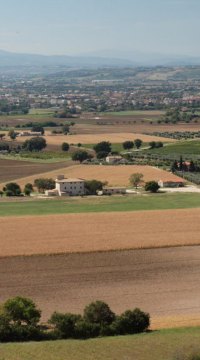Home | About CCW | Contact Us | Climate change Meaning | Causes | Solutions | Emissions | Carbon trading
Tillage
Tillage is what we think we have to do to grow food commercially. We must clear and churn the soil in order to cultivate. But do we?
Around 10,000 years ago, equivalent to yesterday in the grand scheme of things, some clever humans invented agriculture.
They figured out that if you remove the existing vegetation and prepare the soil it was possible to plant, grow and harvest that you wanted all in one place. All you needed was an ability to plough the land.
Turning over of soil to grow crops was much easier than sifting through the natural vegetation for the most nutritious plants. Foraging required scouring the bush for hours among the dozens of inedible or poisonous pants just to find one that was safe to eat. With turning of the soil you could plant what you wanted in one place. Food now came to you rather than you going to find it.
This saved time and effort; time that could be better spent on social and cultural activity or fighting your neighbors. It also meant that not everyone had to forage for food - a few could feed the many. The opportunity for all sorts of mischief was born.

We often forget how profound, and how recent, this change was.
Early agriculture required tillage. It was necessary to clear vegetation and then plough the soil to make the ground and create space for the crop, space for the plants you wanted.
This is why domestication of draught animals and the invention of the plough – or perhaps it was the other way around – is often quoted as the invention of agriculture.
The process of ploughing, turning over of the soil to create a clear space for the seedlings of the crop plants, has been going on ever since.
Land is converted to agriculture by cutting down the trees, burning the residue and then ploughing the soil to create an orderly space, free of competing plants with a surface broken up and ready to receive seeds.
We have managed to do this to more than a third of the land area on earth. And today our fields feed more than 7 billion people.

What does tillage have to do with climate change?
Tillage releases carbon to the atmosphere.
One quarter of global greenhouse gas emissions are the result of land clearing for agriculture, the process if cutting trees, burning and ploughing accounts for a fifth of CO2 emissions every year. The carbon stored in the vegetation is released (burnt or decomposed) as we remove it to grow crops.
Soil is now exposed to the air and sun.
Once exposed to the air, carbon stored in the soil is readily oxidized (oxygen is added to the carbon to produce CO2). This release of carbon can be greater than that lost from the vegetation as there can be as much carbon stored in soil as in trees.
Carbon is vital to healthy soil. It is the basis of the biological renewal that must occur to keep moisture and nutrients where the plant roots can access them. Soil depleted in carbon looses structure, nutrients and moisture, will dry out and rainfall will run off the surface.
Commercial crop production is easier (and therefore more profitable) if fields are large, uniform and the farming process mechanised. Tillage helps create uniformity.
Agricultural research has established that tillage, especially the deep ploughs hauled behind tractors, is not essential to crop production.
Less frequent shallow ploughing, called minimum till, maintains yields and retains soil carbon.
Even no-till systems where seeds of crops plants are drilled directly into the existing vegetation (usually pastures) yield productive crops.
Reduced ploughing helps to retain carbon in soil with long term benefits to crop production and a reduced need to apply fertilizers, herbicides and pesticides. As the carbon and dollar cost of these inputs increases so too will the proportion of farmers adopting low-till and no-till cropping systems – because it will make commercial sense.

Back to top of Tillage | Back to agriculture and climate change | Back to climate-change-wisdom home page

Recent Articles
-
Reducing emissions while looking for solutions...
Nov 01, 15 04:46 PM
I've seen a lot of post's online for ideas on reducing emissions. The one suggestion I have not seen, is the most obvious. There should be a government -
Climate change evidence
Mar 24, 15 06:22 AM
Real climate change evidence has to demonstrate a change in climate. An extra sunny day or a severe storm or a flood is not enough. -
The climate change effect
Feb 19, 15 03:08 AM
What will be the climate change effect? There isn't one, there are many. Perhaps too many for us to understand.

New! Comments
Have your say about what you just read! Leave me a comment in the box below.